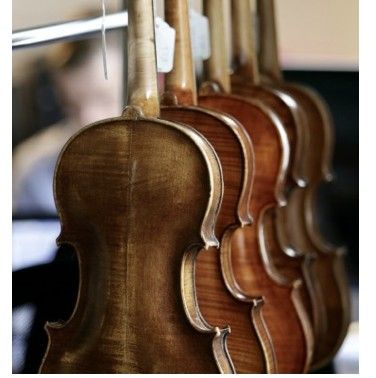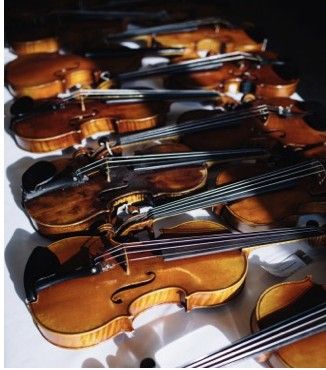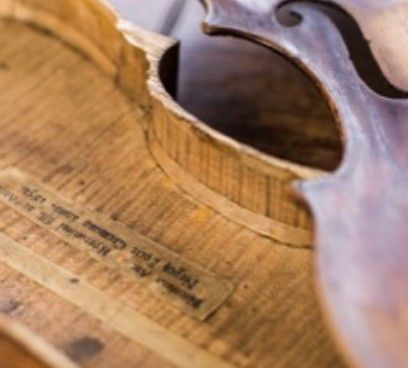Find Your Violin Worth Today
William WALTON
He was born at Longton, Aug. 7, 1860, and he now lives at Howick Station, Longton, near Preston. He is the son of Henry and Jane Walton, and is the eldest child of a family of ten. He was educated at the national school of his native village. In the year 1871 he was sent to work in a cotton-mill, where he remained till he was twenty. In 1880 he joined the railway service, where he steadily worked himself up through the various grades till, in 1889, he was appointed stationmaster of Howick, a rapidly growing district. He was married on October 18, 1884, at Saul Street Chapel, Preston, to Alice, daughter of Lawrence Hunt, of Hoole. He has three children, named Jane, John, and Alice Hunt. He commenced violin-making en amateur in 1887, and since then he has turned out one or two instruments every year, besides repairing a great number. In 1893 he became interested in the varnish question, and was soon deep in experiment. With the help of a friendly chemist he at last succeeded in producing an amber oil varnish of excellent pate and lustre. This splendid solution is elastic, tough, and beautifully transparent. It consists of pure amber in solution in oil, with the colour developed (not added) during the process. Mr. Walton uses beautiful wood of excellent properties. In one instance he has used Oregon pine for the belly, and the result compares very favourably with that of more orthodox material. He works on the Joseph lines from drawings published by Mr. Honeyman, on the Strad lines after the outlines of Riechers, and also on an original outline and model. The measurements of the last are as follows : — Mr. Walton is a born artist, and his workmanship is magnificent. There is a breadth of conception coupled with tenderness of expression about the work which gives it the air of dignified art. The scroll is thrown with vigour, and the mind is free from suggestions of effort in following the graceful lines of the volute. The same easy flow is observed in the upper and lower turns of the sound-holes. The curve of the model along the longitudinal axes (back and belly) reminds one of the gentle, natural arch of a cord in vibration. The purfling is wide and bold, the margins a little narrow, and the edges round and strong. The corners of the Strad copies have not the Riechers characteristics, being a shade longer, and cut cleanly and square. The button is full, and is perhaps the very tiniest bit too long in proportion to its width — in fact, if it were gently toned down about one thirty-second all round, it would be more in keeping with the highly graceful lines of the original model. The work of this maker merits criticism only from the highest standpoint. In works of the third or even second order, a sixteenth of an inch in any one part, more or less, is immaterial to the physiognomy of the fiddle. Not so in work of the kind under our consideration. The most scrupulous care should be paid to the smallest matter of detail. Nature is particular to the nth, and so must art be if it would be natural. The tone of the two instruments submitted for my inspection is very similar in both cases, and has fulness, equality, sympathy, and carrying power.
Show more Hide textPrice History
| Type | Title | Sold | Price |
|---|---|---|---|
| Violin | 35.6 cm Preston, 1927 n°71 [Attributed to] | Sat 1st October 11 | £ 1875.00 |
| Violin | 35.9 cm Preston, 1913 (restorations) [Attributed to] | Tue 1st December 09 | £ 840.00 |
| Violin | 35.6 cm Preston, 1914 n°49 | Tue 1st December 09 | £ 600.00 |
| Violin | 1902 | Wed 1st March 95 | £ 920.00 |
| Violin | 1906 | Wed 1st June 94 | £ 1150.00 |
| Violin | 1908 | Mon 1st March 93 | £ 1100.00 |
| Violin | 1902 | Sat 1st June 91 | £ 3520.00 |
| Violin | 1915 | Fri 1st June 90 | £ 495.00 |
| Violin | 1918 | Sat 1st November 86 | £ 880.00 |
| Violin | 1913 | Thu 1st May 86 | £ 702.00 |
| Violin | 1911 | Sat 1st March 86 | £ 475.00 |
| Violin | Wed 5th October 11 | £ 1875.00 |
Similar Makers
Books by Amati
Amati, in collaboration with leading experts, have published a few key books in the field of stringed instruments.
Explore more


